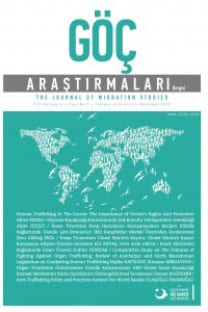Uluslaraşırı Köprüler Olarak Memleket Dernekleri: Avusturya'daki Türk Kültürel Birliğinin Vaka Analizi
Bu araştırma makalesi, hem Viyana’daki hem de diğer yerlerdeki Türk memleket dernekleri örneğine bakarak Avrupa’daki göç oluşumlarının geçiş süreçleri ve gelişim süreçleri konusundaki bilgilerimizi pekiştirmeyi hedefler. Neoliberal süreçlerin ve küreselleşen göçmenliğin ışığında, vaka analizi, göçmenlerin yerleşim ülkesindeki uzun geçmişine rağmen, belirli göçmen oluşumlarının neden ve nasıl berlirli zaman dilimlerinde ortaya çıktığı konusunda bazı önemli sonuçlar ortaya koymaktadır. Araştırma kapsamında, derneğin göçmenlerin kendi bölgelerinin ötesindeki ülkelerdeki ulusötesi köprülerin hem inşasına hem de sürekliliğine katkıda bulunan stratejilerine ve etkinliklerine yer verilmiştir. Araştırma, dernek başkanıyla yapılan görüşmelerini kullanır ve niçerik analizi uygular.
Anahtar Kelimeler:
Göç Çalışmaları, Ulusötesi Göç, Memleket Dernekleri
Hometown Associations as Transnational Bridges: A Case Analysis of a Turkish Cultural Association in Austria
In this research article, I aim to consolidate our knowledge in the developmental processes and the transnational implications of migration formations in Europe by referring to the case Turkish hometown association both in Vienna and other locations. Within the understanding of neoliberal agendas and the globalizing forms of migration, the case analysis suggests some important results as to why and how certain migration formations emerge at particular times despite the migrants’ long history in the country of settlement. Besides, I point out to the association’s strategies and events that contribute to both the construction and sustenance of the transnational bridges across countries beyond the singular localities of migrants. The research utilizes narrative interviewing conducted with the association’s president, and applies content analysis based on the association’s online presence.
___
- Al-Ali, Nadje, Richard Black & Khalid Koser. (2001). The limits to ‘transnationalism’: Bosnian and Eritrean refugees in Europe as emerging transnational communities, Ethnic and Racial Studies, 24:4, 578-600
- Caglar, Ayse. (2013). Locating Migrant Hometown Ties in Time and Space. Historische Anthropologie, 21(1), pp. 26-42. Retrieved 14 June 2019.
- Caglar, Ayse. (2006). Hometown Associations, The Rescaling of State Spatiality and Migrant Grassroots Transnationalism. Global Networks. 6. pp. 1 - 22.
- Caglar, Ayse & Glick Schiller, Nina. (2018). Migrants and City-Making: Dispossession, Displacement, and Urban Regeneration.
- Europe Haber. 27-10-2011. ASBİR Viyana göreve hazır. Retrieved 23 June 2019. http://www.europahaber.de/asbir-viyana-goreve-hazir/2351/
- Schiller, Nina Glick & Bash, Linda & Szanton Blanc, Cristiana. (1994). Nations Unbound: Transnational Project, Postcolonial Predicaments and Deterritorrialized Nation-States. Langhorne: Gordon and Breach.
- Karatani, Rieko. (2005). How History Separated Refugee and Migrant Regimes: In Search of Their Institutional Origins. y Oxford University Press.
- Mayer, Margit. (2018). Cities as Sites of Refuge and Resistance. European Urban and Regional Studies. Vol. 25(3). pp. 232–249.
- MCEWAN, CHERYL , JANE POLLARD and NICK HENRY. (2005). The ‘Global’ in the City Economy: Multicultural Economic Development in Birmingham. Blackwell Publishing. Volume 29.4. pp. 916–933.
- Peggy Levitt & Rafael de la Dehesa (2003). Transnational migration and the redefinition of the state: Variations and explanations, Ethnic and Racial Studies, 26:4. pp. 587-611.
- Schiller, Nina Glick, Ayse Çağlar (2009): Towards a Comparative Theory of Locality in Migration Studies: Migrant Incorporation and City Scale, Journal of Ethnic andMigration Studies, 35:2. pp 177-202.
- Orozco, Manuel; Welle, Katherine. (2005). Hometown Associations and Development: A Look at Ownership, Sustainability, Correspondence, and Replicability. Retrieved on 23 June 2019.
- Orozco, Manuel. (2005). Migrant Hometown Associations: Putting a Face to Globalization. Harvard Journal of Hispanic Policy. Vol. 17.
- Pries, L. (2001). The Disruption of Social and Geographic Space: Mexi¬can-US Migration and the Emergence of Transnational Social Spaces. In¬ternational Sociology, 16(1). pp. 55–74.
- Portes, A. (2001). Introduction: The Debates and Significance of Immig¬rant Transnationalism. Global Networks. 1. pp. 181-194.
- Smith, Michael, Luis Guarnizo. (1998). Transnationalism From Below. Comparative Urban and Community Research V6. New Brunswick: Trans¬action Publishers. pp. 1-33. http://citeseerx.ist.psu.edu/viewdoc/down¬load?doi=10.1.1.510.2934&rep=rep1&type=pdf
- Somerville, Will, Jamie Durana, Aaron Matteo Terrazas. (2008). Home¬town Associations: An Untapped Resource for Immigrant Integration? Migration Policy Institute.
- https://www.yenisafak.com/kultur-sanat/sivas-halisi-avrupaya-aciliy¬or-560808
- http://beyazgazete.com/haber/2013/9/4/sivas-halisi-avrupa-ya-aciliy¬or-1933732.html
- https://www.facebook.com/photo.php?fbid=1785368324841369&set =a.331473263564223&type=3&theater
- https://www.facebook.com/photo.php?fbid=1642438625801007&set =a.331473263564223&type=3&theater
- http://www.europahaber.de/asbir-viyana-goreve-hazir/2351/
- https://www.postaktuel.com/asbir-tastanla-devam/
- http://www.sivasirade.com/haber/-749.html
- http://www.mootol.com/Haber717/turkiyede-bir-ilki-gerceklestirecek
- ISSN: 2149-5548
- Başlangıç: 2015
- Yayıncı: Göç İdaresi Genel Müdürlüğü
